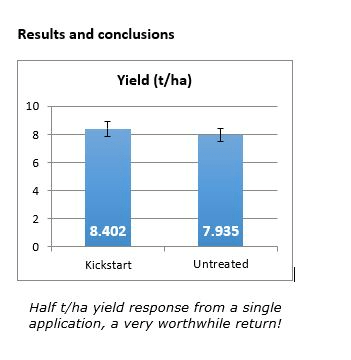This nutritional agronomy update looks at how to remedy sub-optimal planting conditions
Rain – a prominent feature on most farmers landscapes throughout autumn and into January. With prolonged wet weather brings unwanted waterlogged fields, with crops in sub-optimal conditions or not yet planted. However, with a few more weeks of dry weather Spring is just around the corner, and the importance of getting crops of to the best start is clear.
Rooting is a vital stage in crop development, strong roots create the basis for healthy plants able to withstand the stresses of the growth cycle. However, during a season where many crops where unable to get in the ground during Autumn, it’s critical those planted in Spring flourish and deliver a high return on investment. Additionally, those planted will be heading into soils with potentially wet soil and poor structure, creating less than ideal conditions to grow in, and in some cases inducing stress for the crop.
 Kickstart Trial 1
The chart highlights that the treated crop developed faster than the untreated, and that this effect increased rather than diminished with time after the application.
Trials conducted at Nottingham University showed an average increase in root mass of 38% when applied at 3 true leaves compared to the untreated plants. It is vital that there is a significant root mass to allow the plants to maximise yield potential. A larger root mass increases the plants ability to uptake nutrition and water.
Randomised replicated plot trials at the end of the growing season showed a half t/ha yield response, proving the value of boosting early establishment in cereals.
Kickstart Trial 1
The chart highlights that the treated crop developed faster than the untreated, and that this effect increased rather than diminished with time after the application.
Trials conducted at Nottingham University showed an average increase in root mass of 38% when applied at 3 true leaves compared to the untreated plants. It is vital that there is a significant root mass to allow the plants to maximise yield potential. A larger root mass increases the plants ability to uptake nutrition and water.
Randomised replicated plot trials at the end of the growing season showed a half t/ha yield response, proving the value of boosting early establishment in cereals.
 Kickstart Yield Trials Results
Kickstart Yield Trials Results
How to remedy sub-optimal planting conditions - Establish healthy root structures
Phosphite is a key constituent of healthy rooting, shown to promote early root growth in young plants. Kickstart, OMEX’s foliar applied phosphite formulated with nitrogen and potassium, is a simple foliar application that improves crop establishment and root growth. Kickstart’s effectiveness has been demonstrated in fully replicated independent trials, Kickstart was found to be the best performing foliar root stimulator of all products tested. OMEX has also conducted on farm trials. It also aids the uptake and systemic movement of co-applied nutrient cations within the plant, creating an overall healthier crop.Trials Results
In field trials, recorded crop development, was noticeably faster in the Kickstart treated areas. Furthermore, this effect continued throughout the season with the treated crop showing more growth and darker leaves. Kickstart Trial 1
The chart highlights that the treated crop developed faster than the untreated, and that this effect increased rather than diminished with time after the application.
Trials conducted at Nottingham University showed an average increase in root mass of 38% when applied at 3 true leaves compared to the untreated plants. It is vital that there is a significant root mass to allow the plants to maximise yield potential. A larger root mass increases the plants ability to uptake nutrition and water.
Randomised replicated plot trials at the end of the growing season showed a half t/ha yield response, proving the value of boosting early establishment in cereals.
Kickstart Trial 1
The chart highlights that the treated crop developed faster than the untreated, and that this effect increased rather than diminished with time after the application.
Trials conducted at Nottingham University showed an average increase in root mass of 38% when applied at 3 true leaves compared to the untreated plants. It is vital that there is a significant root mass to allow the plants to maximise yield potential. A larger root mass increases the plants ability to uptake nutrition and water.
Randomised replicated plot trials at the end of the growing season showed a half t/ha yield response, proving the value of boosting early establishment in cereals.
 Kickstart Yield Trials Results
Kickstart Yield Trials Results
